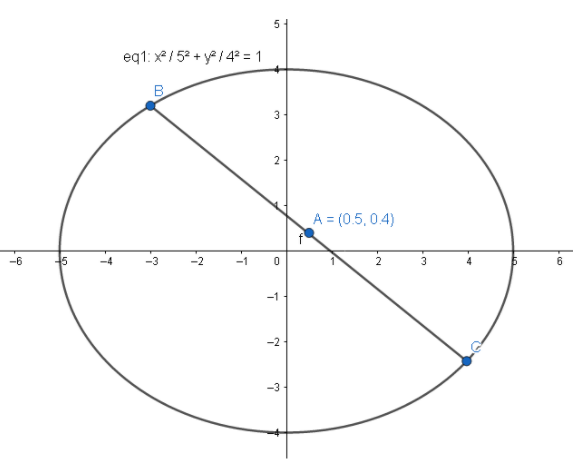
Find the length of the chord of the ellipse
Answer
498.6k+ views
Hint: To solve the question first, we have to find out the equation of the chord. The intersection points of the chord and ellipse can be found out by solving the equations of the chord and ellipse. Finally, by using the distance formula we get the distance between two intersection points that is the length of the chord.
Complete step-by-step solution:

We know that the general equation of an ellipse with semi major axis ’a’ and semi minor axis ‘b’ is given by
From the question the equation of the ellipse is given by
We know the formula that the equation of the chord of an ellipse
Applying this formula, the equation of the chord of
From eq. (4) we can deduce
Substituting the value of x in Eq. (5) we get the values of y.
For
And for
Therefore, the intersection points are
We know the distance between the points joining
Hence applying this formula, we get the distance between the intersection points
Hence we got the length of the chord =
Note: While solving the equations of the chord and the ellipse we must get two coordinates since the degree of the equation of the ellipse is 2 and the obtained coordinates are the intersecting points. In an alternative method, to find the point of intersection of the chord and ellipse we can solve the equations for y and setting the expressions for y equal to each other we get values of x.
Complete step-by-step solution:

We know that the general equation of an ellipse with semi major axis ’a’ and semi minor axis ‘b’ is given by
From the question the equation of the ellipse is given by
We know the formula that the equation of the chord of an ellipse
Applying this formula, the equation of the chord of
From eq. (4) we can deduce
Substituting the value of x in Eq. (5) we get the values of y.
For
And for
Therefore, the intersection points are
We know the distance between the points joining
Hence applying this formula, we get the distance between the intersection points
Hence we got the length of the chord =
Note: While solving the equations of the chord and the ellipse we must get two coordinates since the degree of the equation of the ellipse is 2 and the obtained coordinates are the intersecting points. In an alternative method, to find the point of intersection of the chord and ellipse we can solve the equations for y and setting the expressions for y equal to each other we get values of x.
Recently Updated Pages
Express the following as a fraction and simplify a class 7 maths CBSE

The length and width of a rectangle are in ratio of class 7 maths CBSE

The ratio of the income to the expenditure of a family class 7 maths CBSE

How do you write 025 million in scientific notatio class 7 maths CBSE

How do you convert 295 meters per second to kilometers class 7 maths CBSE

Write the following in Roman numerals 25819 class 7 maths CBSE

Trending doubts
State and prove Bernoullis theorem class 11 physics CBSE

What are Quantum numbers Explain the quantum number class 11 chemistry CBSE

Write the differences between monocot plants and dicot class 11 biology CBSE

1 ton equals to A 100 kg B 1000 kg C 10 kg D 10000 class 11 physics CBSE

State the laws of reflection of light

In northern hemisphere 21st March is called as A Vernal class 11 social science CBSE




